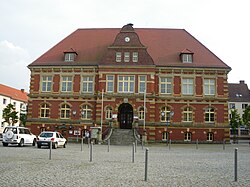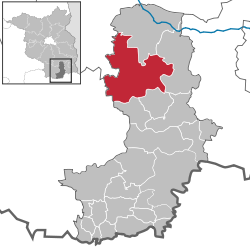Calau
| Calau/Kalawa | ||
|---|---|---|

Town hall of Calau
|
||
|
||
| Coordinates: 51°44′45″N 13°57′03″E / 51.74583°N 13.95083°ECoordinates: 51°44′45″N 13°57′03″E / 51.74583°N 13.95083°E | ||
| Country | Germany | |
| State | Brandenburg | |
| District | Oberspreewald-Lausitz | |
| Government | ||
| • Mayor | Werner Suchner (Ind.) | |
| Area | ||
| • Total | 162.59 km2 (62.78 sq mi) | |
| Population (2015-12-31) | ||
| • Total | 7,833 | |
| • Density | 48/km2 (120/sq mi) | |
| Time zone | CET/CEST (UTC+1/+2) | |
| Postal codes | 03205 | |
| Dialling codes | 03541 | |
| Vehicle registration | OSL, CA, SFB | |
| Website | www.calau.de/ | |
Calau (German pronunciation: [kaːlaʊ], Lower Sorbian: Kalawa) is a small town in the Oberspreewald-Lausitz district, in southern Brandenburg, Germany. It is situated 14 km south of Lübbenau, and 27 km west of Cottbus. Calau is also called the home of the Kalauer.
The Town of Calau is situated in the middle of the Niederlausitz, about 27 km west of Cottbus at the eastern edge of the Lower Lusatian Ridge Nature Park as well as at the southern edge of the famous Spreewald.
The area around Calau is strongly characterized by former brown-coal-mining sites, which are valuable retreat areas for animals and plants nowadays. Many places are left to nature after recultivation, the Heinz-Sielmann-Stiftung adopted numerous areas, others are managed near-natural and sustainably by the "Landesforstverwaltung". Foresters offer walking tours through the region. Particularly the "Geologische und Naturlehrpfad Luttchensberg" is a sight to see.
There are only a few people with Sorbian roots living in Calau today, although the Sorbs were quite a large minority in 1843 with about 30.8 percent of the overall population. In following years the number of Sorbs decreased rapidly, and in 1900 only 3.5 percent of the population were Sorbs.
Development of Population since 1875 within the Current Boundaries (Blue Line: Population; Dotted Line: Comparison to Population Development of Brandenburg state; Grey Background: Time of Nazi rule; Red Background: Time of Communist rule)
...
Wikipedia



